| Garfield Monument | |
|---|---|
 The monument in 2010 | |
 | |
| Location | San Francisco, California, U.S. |
| 37°46′19″N122°27′32″W / 37.77181°N 122.45884°W | |
The Garfield Monument is installed in San Francisco's Golden Gate Park, in the U.S. state of California.
| Garfield Monument | |
|---|---|
 The monument in 2010 | |
 | |
| Location | San Francisco, California, U.S. |
| 37°46′19″N122°27′32″W / 37.77181°N 122.45884°W | |
The Garfield Monument is installed in San Francisco's Golden Gate Park, in the U.S. state of California.

Muir Woods National Monument is a United States National Monument managed by the National Park Service and named after naturalist John Muir. It is located on Mount Tamalpais near the Pacific coast in southwestern Marin County, California. The Monument is part of the Golden Gate National Recreation Area, and is 12 miles (19 km) north of San Francisco. It protects 554 acres (224 ha), of which 240 acres (97 ha) are old growth coast redwood forests, one of a few such stands remaining in the San Francisco Bay Area.

Golden Gate Park is an urban park between the Richmond and Sunset districts of San Francisco, California, United States. It is the largest park in the city, containing 1,017 acres (412 ha), and the third-most visited urban park in the United States, with an estimated 24 million visitors annually.

Garfield Park is a 184-acre (0.74 km2) urban park located in the East Garfield Park neighborhood on Chicago's West Side. It was designed as a pleasure ground by William LeBaron Jenney in the 1870s and is the oldest of the three original parks developed by the West Side parks commission on the Chicago park and boulevard plan. It is home to the Garfield Park Conservatory, one of the largest plant conservatories in the United States. It is also the park furthest west in the Chicago park and boulevard system.

Charles Henry Niehaus was an American sculptor.

Garfield Park is a 128-acre (52 ha) urban park in Indianapolis, Indiana, United States. Established in the late 19th century, it is the oldest city park in Indianapolis and is on the National Register of Historic Places. The park is located at the confluence of Pleasant Run and Bean Creeks on the near Southside of Indianapolis. The 10,000-square-foot (930 m2) Conservatory and Sunken Gardens are located in the eastern portion of the park. The noted landscape architect George Edward Kessler designed the Sunken Gardens along with many of the other features of the park as part of his Park and Boulevard Plan for the city.

The Golden Gate Biosphere Network is a voluntary coalition of federal, state and local government agencies, nonprofit organizations, universities, and private partners within the Golden Gate Biosphere region. The Network aims to protect the region's biodiversity and conserve its natural resources. The Network has been part of the UNESCO Man and Biosphere Programme since 1988.GGBN is also part of the US Biosphere Network as well as EuroMAB. It is recognized by UNESCO for its "significance for biological diversity conversation" and organizational efforts involving municipal authorities and private interests.

The Golden Gate National Recreation Area (GGNRA) is a U.S. National Recreation Area protecting 82,116 acres (33,231 ha) of ecologically and historically significant landscapes surrounding the San Francisco Bay Area. Much of the park is land formerly used by the United States Army. GGNRA is managed by the National Park Service and is the second-most visited unit of the National Park system in the United States, with more than 15.6 million visitors in 2022. It is also one of the largest urban parks in the world, with a size two-and-a-half times that of the consolidated city and county of San Francisco.
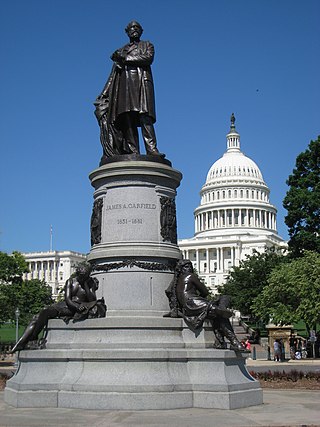
The James A. Garfield Monument stands on the grounds of the United States Capitol in Garfield Circle, a traffic circle at First Street and Maryland Avenue SW in Washington, D.C. It is a memorial to U.S. President James A. Garfield, who was elected in 1880 and assassinated in 1881 after serving only four months of his term. The perpetrator was an attorney and disgruntled office-seeker named Charles J. Guiteau. Garfield lived for several weeks after the shooting, but eventually succumbed to his injuries. The monument is part of a three-part sculptural group near the Capitol Reflecting Pool, including the Peace Monument and the Ulysses S. Grant Memorial in Union Square. The monument is also a contributing property to the National Mall and L'Enfant Plan, both of which are listed on the National Register of Historic Places and the District of Columbia Inventory of Historic Sites. The bronze statue rests on a granite pedestal that features three sculptures, each one representing a time period in Garfield's life.

Piatt Park is the oldest park in Cincinnati, Ohio. The urban park stretches two blocks between Elm Street and Vine Street on Garfield Place/8th Street. The park is owned and maintained by the Cincinnati Park Board.

The James A. Garfield Memorial is the final resting place of assassinated President James A. Garfield, located in Lake View Cemetery in Cleveland, Ohio. The memorial, which began construction in October 1885 and was dedicated on May 30, 1890, exhibits a combination of Byzantine, Gothic, and Romanesque Revival architectural styles. Garfield, former First Lady Lucretia Garfield, and two other members of the Garfield family are entombed in the crypt level of the monument.
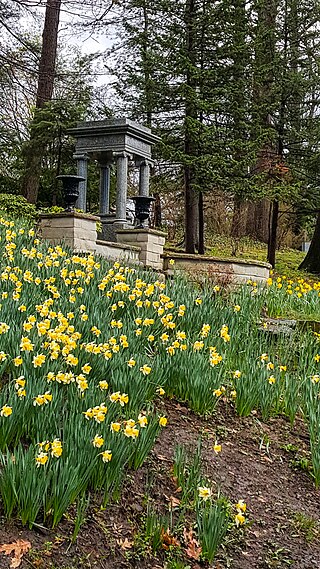
Lake View Cemetery is a privately owned, nonprofit garden cemetery located in the cities of Cleveland, Cleveland Heights, and East Cleveland in the U.S. state of Ohio. Founded in 1869, the cemetery was favored by wealthy families during the Gilded Age, and today the cemetery is known for its numerous lavish funerary monuments and mausoleums. The extensive early monument building at Lake View helped give rise to the Little Italy neighborhood, but over-expansion nearly bankrupted the burial ground in 1888. Financial recovery only began in 1893, and took several years. Lake View grew and modernized significantly from 1896 to 1915 under the leadership of president Henry R. Hatch. The cemetery's cautious management allowed it to avoid retrenchment and financial problems during the Great Depression.

The James A. Garfield Monument is a monument honoring the 20th president of the United States in Philadelphia, Pennsylvania, United States. Sculptor Augustus Saint-Gaudens and architect Stanford White collaborated on the memorial, which was completed in 1896. It is located in Fairmount Park, along Kelly Drive, near the Girard Avenue Bridge.
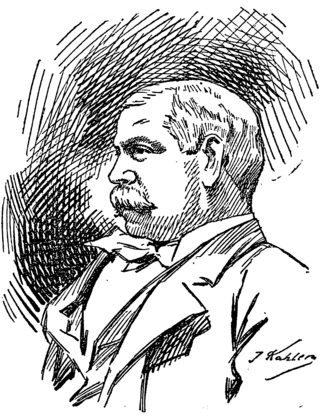
Frank H. Happersberger (1859–1932) was an American sculptor based in San Francisco. He received training in a German royal art academy. He is best known for the monument for President James A. Garfield in Golden Gate Park and Pioneer Monument, both in San Francisco.

The Confederate Soldiers and Sailors Monument was a large granite monument that sat at the south entrance of Garfield Park in Indianapolis for nearly a century, before being removed in 2020. It commemorated the Confederate prisoners of war that died at Camp Morton. At 35 feet (11 m) tall and located in the city's oldest public park, it had been the most prominent of the very few Confederate memorials in the Union state of Indiana. It was dismantled and removed by the city of Indianapolis in June 2020 after a yearslong debate, part of a national wave of removal of Confederate memorials during the Black Lives Matter movement.

A 30-foot (9.1 m) tall statue of Junípero Serra was installed in San Francisco's Golden Gate Park, in the U.S. state of California. It had first been erected in 1907 and sculpted by Douglas Tilden. The memorial was toppled on June 19, 2020, during the George Floyd protests, as a Juneteenth commemoration. The next day another memorial for Serra was torn down in Los Angeles at Father Serra Park by about five dozen indigenous activists. Other statues of Junípero Serra were involved as the protests expanded to include monuments of individuals associated with the controversy over the genocide of indigenous peoples in the Americas. Demonstrators also toppled or otherwise vandalized the statues of Francis Scott Key, Ulysses S. Grant, and a group consisting of Don Quixote and his companion, Sancho Panza, kneeling to honor their creator, Cervantes.
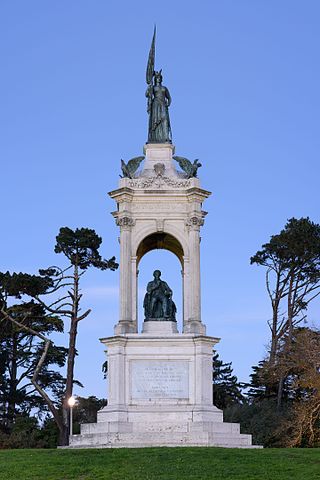
A memorial statue of Francis Scott Key stood in Golden Gate Park, San Francisco, in the U.S. state of California, from 1888 until 2020.
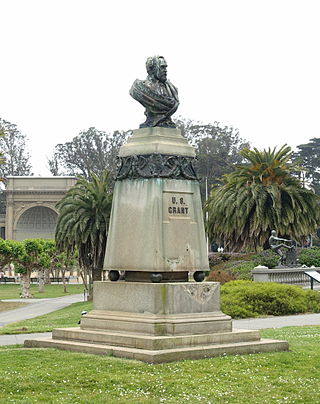
A bronze bust of Ulysses S. Grant was installed in San Francisco's Golden Gate Park, in the U.S. state of California, in 1896 and removed in 2020. The original sculptor of the bust was a renowned German born sculptor by the name of Rupert Schmid who had been noted for his commissioned work including The Progress of Civilization, a memorial arch at Stanford University before it was toppled in an earthquake in 1906.

The William McKinley Memorial is a statue honoring the assassinated United States President William McKinley. It stands at the foot of Panhandle Park, San Francisco, California, and faces the DMV across Baker Street. Created by Robert Ingersoll Aitken (1878–1949) in 1904, the Monument was dedicated in 1903 by President Theodore Roosevelt, who succeeded McKinley after his assassination in 1901. The monument was unveiled on November 24, 1904 at the entrance to the Golden Gate Park panhandle. Over 5,000 people came to the unveiling. Speeches were made by former Mayor James D. Phelan, Mayor Eugene Schmitz, John McNaught, and others.